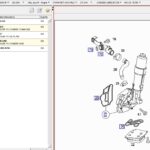Understanding the intricacies of Mercedes-Benz diagnostic systems can be challenging, especially when navigating the landscape of software versions, hardware compatibility, and security features. For professionals and enthusiasts working with Mercedes-Benz vehicles, particularly those around the 2019 model year, the term “Xentry 2019 Long Key Patches” often emerges. This term is closely tied to accessing the full potential of the Xentry diagnostic software, especially when dealing with offline coding and system functionalities. Let’s delve into what Xentry 2019 and these “long key patches” entail, offering clarity for those seeking to optimize their diagnostic capabilities.
To begin, it’s crucial to understand that the term “Xentry” isn’t monolithic. It’s a system comprised of several key components, each playing a vital role in the diagnostic process. These components include the laptop running the Windows operating system, the specific versions of DAS (Diagnostic Assistance System) and Xentry software, and the multiplexer hardware used to interface with the vehicle. When considering a diagnostic setup, especially for vehicles around the 2019 era and earlier, these four variables are paramount. The choice often boils down to user preference – Windows 7 or Windows 10 – and the specific vehicle models and diagnostic tasks at hand.
For vehicles like the older 2006 T1N Sprinter, a C4 multiplexer is often recommended. It’s a versatile option, compatible not only with Xentry but also with other powerful diagnostic software like Vediamo and DTS Monaco. A slightly more advanced option is the C5 multiplexer, which is also suitable for T1N models and newer vehicles. It’s important to note that multiplexers in such setups are often cloned, while the software itself is generally close to genuine, albeit potentially requiring patches. The emergence of key generators capable of producing “long activation keys” for Xentry has lessened the need for extensive software patching in many scenarios. This brings us to the core of “Xentry 2019 long key patches.”
The need for “long key patches” arises primarily from the software licensing and activation mechanisms implemented by Mercedes-Benz. These patches are essentially workarounds designed to extend the functionality of Xentry software, particularly for users who may not have access to official Mercedes-Benz server authentication. Prior to October 13, 2020, server access checks primarily focused on user credentials and software activation keys. However, since then, Mercedes-Benz has implemented hardware ID verification. This means non-genuine hardware is effectively blocked from accessing online server functions for coding and other advanced operations. This change was aimed at pushing independent workshops towards genuine Mercedes-Benz diagnostic equipment, such as Kit 3 or Kit 4.
Mercedes-Benz also incorporated a diagnostic firewall in vehicles manufactured from 2019 onwards. This firewall requires unlocking before in-depth diagnostics or variant coding can be performed. This further complicates the use of third-party diagnostic tools on newer models, potentially limiting their coding capabilities unless manufacturers establish formal agreements with Mercedes-Benz.
In the context of Xentry 2019, “long key patches” often refer to methods of bypassing or extending the software’s activation period, enabling offline coding, or unlocking developer mode features that might otherwise be restricted. It’s crucial to understand that offline coding capabilities are intrinsically linked to the DAS software, which is used for Mercedes-Benz vehicles manufactured up to 2013. Xentry, introduced for 2014 and newer models, does not inherently support offline coding in the same way.
For vehicles manufactured in 2013 and earlier, offline coding is possible within DAS versions like the 12.2019 release and older. Achieving this often requires patching DAS with specific files to unlock the offline coding option and necessitates a comprehensive database of CFF/CBF/SMR-D files for the actual coding procedures. Therefore, when users search for “xentry 2019 long key patches,” they might be looking for solutions that, while associated with the 2019 software era, are actually leveraging the capabilities of the older DAS system for offline functionalities on compatible vehicles.
It’s also important to note the software evolution. For instance, the 12.2019 DAS/Xentry version is often favored for its broad compatibility, covering T1N, NCV3 Sprinters, and offering limited access to the newer W907 2019+ Sprinters. Furthermore, versions up to 03.2020 are notable as they include a DAS version with developer mode, a feature absent in newer iterations. The 03.2020 version also marks the last compatible release for Windows 7, with subsequent versions requiring Windows 10.
For diagnostic tasks on 2014 and newer vehicles where offline coding with Xentry is not directly available, alternative solutions like Vediamo and DTS Monaco, used in conjunction with C4 or C5 multiplexers, become relevant. These tools offer advanced functionalities for offline updates, flashing, and variant coding changes.
In conclusion, “Xentry 2019 long key patches” is a term that encapsulates the efforts to maximize the utility of Mercedes-Benz diagnostic software around the 2019 timeframe, particularly in scenarios involving non-genuine hardware or the desire for offline coding capabilities. Understanding the interplay between Xentry, DAS, multiplexer hardware, software versions, and the evolving security measures implemented by Mercedes-Benz is key to navigating this complex landscape effectively. For those seeking a robust setup, a C4 or C5 multiplexer with a 12.2019 DAS/Xentry release on a 64-bit Windows 7 Ultimate system remains a highly recommended configuration, offering broad vehicle coverage and access to essential diagnostic features. For advanced users, mastering DAS/Xentry along with Vediamo/DTS Monaco and utilizing seed key calculators can further expand diagnostic and coding capabilities.
